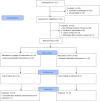This is a preprint.
Linking Physical Activity to Personal Values: Feasibility and Acceptability Randomized Pilot of a Behavioral Intervention for Older Adults with Osteoarthritis Pain
- PMID: 35018370
- PMCID: PMC8750708
- DOI: 10.21203/rs.3.rs-1182374/v1
Linking Physical Activity to Personal Values: Feasibility and Acceptability Randomized Pilot of a Behavioral Intervention for Older Adults with Osteoarthritis Pain
Update in
-
Linking physical activity to personal values: feasibility and acceptability randomized pilot of a behavioral intervention for older adults with osteoarthritis pain.Pilot Feasibility Stud. 2022 Aug 1;8(1):164. doi: 10.1186/s40814-022-01121-0. Pilot Feasibility Stud. 2022. PMID: 35915512 Free PMC article.
Abstract
Background Osteoarthritis (OA) pain is common and leads to functional impairment for many older adults. Physical activity can improve OA outcomes for older adults, but few are appropriately active. Behavioral interventions can reduce barriers to physical activity. We developed and tested a brief, novel behavioral intervention for older adults combining values to enhance motivation and strategic activity pacing to improve arthritis-related pain and functioning and increase physical activity. Methods A randomized feasibility and acceptability pilot trial compared Engage-PA to treatment as usual plus fitness tracker (TAU+) in N=40 adults age 65+ with OA pain in the knee or hip. Engage-PA involved two 60-minute telephone sessions. All participants wore a fitness tracker to collect daily steps throughout the study and completed baseline and post-treatment assessments of secondary outcomes (arthritis-related pain and physical functioning, physical activity, psychological distress, psychological flexibility, and value-guided action). The impact of COVID-19 on general wellbeing and physical activity was also assessed. Descriptive statistics were conducted for feasibility and acceptability outcomes. Indicators of improvement in secondary outcomes were examined via change scores from baseline to post-treatment and performing independent samples t -tests to assess for between-group differences. Results Feasibility was high; 100% accrual, low (5%) attrition, and 100% completion of study sessions. Acceptability was high, with 89% finding the intervention "mostly" or "very" helpful. Engage-PA participants demonstrated improvements in arthritis pain severity ( M diff =1.68, p <.05), arthritis-related physical functioning ( M diff =.875, p =.056), and self-reported activity ( M diff =.875, p <.05) from baseline to post-treatment as compared to TAU+. Sixty-three percent of participants provided useable objective daily steps data. Other secondary outcome patterns were not interpretable in this small sample. COVID-19 added additional burden to participants, such that 50% were exercising less, 68% were more sedentary, and 72% lost access to spaces and social support to be active. Conclusions Engage-PA is a promising brief, novel behavioral intervention that has potential to support older adults in improving arthritis-related pain and functioning and increasing physical activity. The feasibility and acceptability of the intervention is particularly notable as most participants reported COVID-19 added more barriers to physical activity, and Engage-PA may be appealing in future studies. Trial Registration: clinicaltrials.gov, NCT04490395, registered 7/29/2020, https://clinicaltrials.gov/ct2/show/NCT04490395.
Conflict of interest statement
References
-
- WHO | Information sheet: global recommendations on physical activity for health 65 years and above [Internet]. WHO. [cited 2020 Jan 28]. Available from: https://www.who.int/dietphysicalactivity/publications/recommendations65y...
-
- Felson DT. The course of osteoarthritis and factors that affect it. Rheum Dis Clin North Am. 1993. Aug;19(3):607–15. - PubMed
-
- Marshall K, Hale D. Older Adults and the Opioid Crisis. Home Healthcare Now. 2019. Apr;37(2):117. - PubMed
-
- Physical Activity Helps Arthritis Pain | CDC; [Internet]. 2019. [cited 2020 Sep 16]. Available from: https://www.cdc.gov/arthritis/communications/features/physical-activity-...
Publication types
Associated data
Grants and funding
LinkOut - more resources
Full Text Sources
Medical


